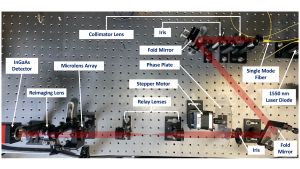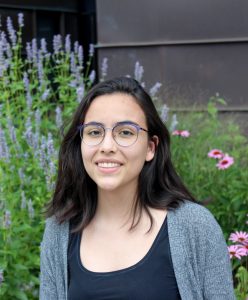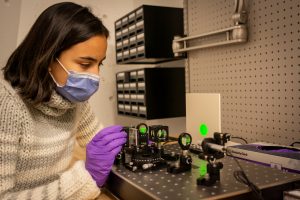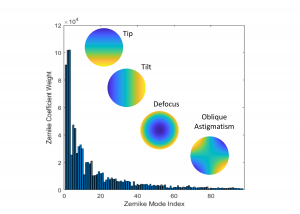Libertad (Libby) is a fourth-year undergraduate student specializing in Physics and Astrophysics at the University of Toronto Scarborough. She grew up playing under the rain and mud of her hometown. This exposure to nature led her to develop a deep curiosity and passion for the unknown.
Although she was born in Santa Cruz, Bolivia, Libby has lived in Brazil, Australia, and Argentina as well. Being always on the move, she spends most of her free time exploring new cities and embarking on adventures to find secret libraries and cafes as well as the best places to eat. However, when she is not outside or deep in thought at the corner of a library, Libby also enjoys handcrafting bracelets and singing.
Fun Fact: “Libertad” in Spanish means freedom.
What made you decide to participate in SURP?
As someone who never stopped asking questions, I have always been intrigued by all the unexplainable phenomena of our universe. This curiosity is what led me to study and become interested in the experimental aspects of astrophysics and astronomy. In the search for opportunities to gain research experience as an undergraduate student, I encountered SURP. When I learned it not only promoted the learning of soft skills in scientific communication but also allowed students to learn and work with passionate physicists and astronomers, I was determined to participate.
Can you tell us about your research project?
My project, supervised by Prof. Suresh Sivanadam and Dr. Momen Diab, focused on working with a Shack Hartman wavefront sensor (SH-WFS) to reconstruct distorted wavefronts using Zenike modal fitting. This is part of the procedure used in an Adaptive Optics (AO) system, which is a technology that can be used to correct wavefront distortions caused as a beam propagates through Earth’s atmosphere.
Through the use of an optical bench SH-WFS setup and computer simulations, we were able to determine the weights of all of Zernike modes that made up the distorted wavefront. In a classical AO system, a methodology already exists to use this data to correct for these aberrations; however, in our case, a novel photonic corrector will be used to correct the wavefront which requires sensing the incident wavefront before applying the correction. This will require further testing of the photonic chip to establish how to achieve wavefront reconstruction.
What is your favourite thing about SURP?
Unlike lab courses, in SURP I was exposed to realistic research scenarios where things will not always work as expected or problems will arise as an experiment progresses. This opportunity taught me how to reorganize myself and take control of unpredictable situations by learning new creative ways to approach different problems, which is something that cannot be taught through textbooks. Additionally, the flexibility of the working schedule without constant deadlines allowed me to truly enjoy the work I was doing and remember why I had chosen my program in the first place.

SH-WFS testing optical setup. A fiber-coupled laser is collimated by a lens, a phase screen that introduces atmospheric like distortion is placed in the pupil plane, and two relay lenses are then used to image the phase screen on the MLA. A 1:1 lens system image the focal spots created by the Microlens Array on the InGaAs detector. Credit: Libertad Rojas.
Can you explain how SURP has been different from your undergrad work?
During my undergraduate studies, I have taken various astronomy and physics courses with concepts that occasionally overlapped. However, SURP provided me with my first opportunity to combine and apply my knowledge of optics, photonics, and astronomy along with my programming skills to help me understand and work on my project. Furthermore, SURP provided students with exposure to the scientific community by giving us the chance to present our projects as a research poster to the department and members of the public at the end of the program.
What are your plans for the future?
I plan to continue making the most out of all the opportunities I have to gain more research experience. In the near future, I want to continue my studies through graduate school and stay within the experimental side of this field; however, I am still exploring the different areas of study within astronomy and physics. The one thing I am sure of is that I will keep allowing my passion for research to guide me as it always has.
The Dunlap Institute for Astronomy and Astrophysics at the University of Toronto is an endowed research institute with over 80 faculty, postdocs, students, and staff, dedicated to innovative technology, ground-breaking research, world-class training, and public engagement.
The research themes of its faculty and Dunlap Fellows span the Universe and include: optical, infrared and radio instrumentation, Dark Energy, large-scale structure, the Cosmic Microwave Background, the interstellar medium, galaxy evolution, cosmic magnetism, and time-domain science.
The Dunlap Institute, the David A. Dunlap of Astronomy and Astrophysics, and other researchers across the University of Toronto’s three campuses together comprise the leading concentration of astronomers in Canada, at the leading research university in the country.
The Dunlap Institute is committed to making its science, training, and public outreach activities productive and enjoyable for everyone of all backgrounds and identities.



